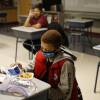When Gov. Charlie Baker's administration announced its decision to soon end the statewide school mask mandate, officials cited a decrease in COVID-19 cases as part of their reasoning.
The latest data show a clear trend: Cases among Massachusetts' K-12 students have plummeted since the peak of the omicron surge in early January. Still, public health experts and elected officials stress the need for continued protective measures, especially in vulnerable communities with lower levels of vaccination and a higher percentage of positive cases.
The positivity rate for pool-testing of K-12 public school students has reached 3.3%, according to figures released by the state Department of Elementary and Secondary Education on Thursday. That's down from a high in the first week of January of 20.1%.
Those figures mirror trends in the broader population. The Department of Public Health on Thursday reported a statewide 3.8% positivity rate, compared to the omicron peak of 23.1%. And the seven-day average of new confirmed cases is down to 1,768, compared to a peak of 23,177 in early January.
While it’s heartening to see these numbers come down, infectious disease physician Dr. Cassandra Pierre said it's important to remember other concerning metrics — like hospitalizations — remain high, and certain communities still face high infection risks.
Pierre, the hospital epidemiologist at Boston Medical Center, said hospitalizations are "coming down from a very high level, which means that there's still a significant component of our state, of our counties and of our neighborhoods that continue to experience transmission.”
She said she’s particularly concerned about how the end of the statewide school mask mandate will affect those communities.
"You could have a COVID positivity of 3.3% in a vulnerable neighborhood and know that right after your February holiday, when this mandate is due to expire, a lot of kids might come back into the school and that positivity [rate] might shoot up, leaving those children unprotected in their relative lack of vaccination,” Pierre said.
According to the state Department of Public Health, just 26% of 5- to 11-year-olds in Lowell are fully vaccinated, and only 14% of those children in Brockton — two communities where DESE reports test positivity rates are nearly double the statewide average.
In announcing the end of the statewide mask mandate, Education Secretary James Peyser said districts can employ their own mandates. Boston is doing just that.
Though the city's K-12 student positivity rate last week was just below the statewide average — at 3.2% — officials are concerned that number is still not low enough to warrant lifting masks, considering student vaccination rates. Less than a third of 5- to 11-year-olds in the city are fully vaccinated, as well as less than half of 16- to 19-year-olds.
“Our Boston Public Health Commission has determined that we need to see [a] consistent downward trend of these [case and positivity] numbers so that we're not just dipping above and below, above and below,” Boston Mayor Michelle Wu said in announcing that the city will require masks after the statewide mandate ends Feb. 28.
Pierre, who is also a member of Wu’s COVID-19 Advisory Committee, says looking at city- or town-level data can be misleading, because it can miss differences at the neighborhood level.
In Boston, the latest seven-day average test positivity,according to the Boston Public Health Commission, was 6.9% on Monday for the entire city. Several neighborhoods were higher than that, with Charlestown at 8.7%, South Boston and South Dorchester at 9.1%, and East Boston at 10.1%. Jamaica Plain, Hyde Park, West Roxbury and Roslindale were all close to 5%.
"You'll have areas of very low positivity, and in another part of the city, very high levels of positivity because of what we know to be lots of different factors that have led to the disinvestment in communities of color,” Pierre said. “And so many communities of color and other structurally vulnerable populations might have much higher levels of positivity … there are populations within that 3.3% [statewide student positivity rate] that we may not know the true state of risk within.”








